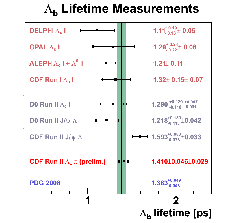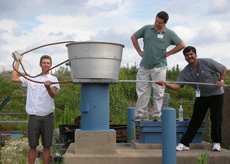Λb lifetime dilemma settled in a tie-breaker

The new Λb lifetime measurement from world's largest Λb sample is compared with the current world average and all the measurements contributing to it.
Measurements of B-hadron lifetimes are important probes for understanding Quantum Chromodynamics, the theory of the strongest force of nature. In particular, they test the validity of a viewpoint, found in the Heavy Quark Effective Theory. This theory treats the heavy b-quark and the light quark partners that make up B-hadrons similarly to the heavy nucleus and the light electron that make up a hydrogen atom. The lifetimes of B mesons (B+, B0 and now Bs, which each contain a b-quark and a light quark) are precisely measured and in good agreement with HQET predictions. But a precise determination of Λb baryon (a bound state of a b-, a u- and a d-quark) lifetime has remained elusive due to lack of experimental statistics. Also, its HQET prediction is different from that of the B mesons, making it very interesting from a theoretical standpoint.
The Λb lifetime puzzle surfaced in the early '90s when the experimental world average, including measurements from both LEP and the Tevatron, was more than two standard deviations below the theoretical prediction. By 2004, the inclusion of higher-order effects lowered the theory prediction and significantly reduced the difference with respect to the experimental measurements. In 2006, CDF's measurement in Λb to J/ψ Λ decay mode stirred the controversy all over again -- the measurement was as precise as the world average, but higher by 2.5 sigma.
CDF physicists have just completed a new Λb lifetime measurement using about 3,000 fully reconstructed Λc π decays, based on 1 inverse femtobarn of data. These events were collected using CDF's displaced track triggers, which, by construction, severely distorted the lifetime distribution. The current measurement employs a novel Monte Carlo-based technique to extract the lifetime in the presence of such bias.
This new tie-breaker lifetime result falls between the old measurements and the CDF result from 2006. It is in agreement with both with a factor of two smaller errors. It also agrees with the latest theory predictions, confirming the HQET view of the decays of beautiful baryons.
Read more

Left to right: CDF physicists Reid Mumford, Petar Maksimovic and Satyajit Behari, all from Johns Hopkins University, untangled the lifetime information from a trigger-biased data sample. Not pictured: Michael Schmidt, University of Chicago; Mat Martin, Johns Hopkins University; Dmitri Litvintsev, Fermilab; and Jen Pursley, University of Wisconsin
|